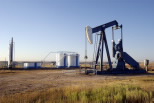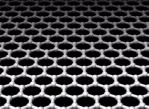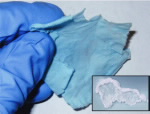FOR IMMEDIATE RELEASE
ACS News Service Weekly PressPac: March 10, 2010
ACS News Service Weekly PressPac: March 10, 2010
Contact
- Science Inquiries: Michael Woods, Editor, 202-872-6293
- General Inquiries: Michael Bernstein, 202-872-6042
![]()
In a finding that may speed efforts to conserve oil and intensify the search for alternative fuel sources, scientists in Kuwait predict that world conventional crude oil production will peak in 2014 — almost a decade earlier than some other predictions. Their study is in ACS’ Energy & Fuels, a bi-monthly journal. Ibrahim Nashawi and colleagues point out that rapid growth in global oil consumption...
![]()

People in seven European countries have positive attitudes toward a new eco-friendly toilet that could substantially reduce pollution problems and conserve water and nutrients, scientists in Switzerland are reporting. Their article, which calls on authorities to give wider support for the innovative toilet technology, is in ACS’ Environmental Science & Technology, a semi-monthly journal. Judit Lienert...
![]()

Scientists have leaped over a major hurdle in efforts to begin commercial production of a form of carbon that could rival silicon in its potential for revolutionizing electronics devices ranging from supercomputers to cell phones. Called graphene, the material consists of a layer of graphite 50,000 times thinner than a human hair with unique electronic properties. Their study appears in...
![]()

Scientists in Texas are reporting development of a first-of-its-kind cloth that releases nitric oxide gas — an advance toward making therapeutic socks for people with diabetes and a wrap to help preserve organs harvested for transplantation. The study is in ACS’ Chemistry of Materials, a bi-weekly journal. Kenneth Balkus and Harvey Liu note in the new study that nitric oxide (NO). Kenneth Balkus...
![]()
Fifty years after the first laser sparked a technological revolution, the “light fantastic” continues to impact people’s daily lives — by playing DVDs, speeding Internet connections, and performing intricate surgery. As the golden anniversary of the announcement of the first laser approaches on July 7th, Chemical & Engineering News (C&EN), ACS’ weekly newsmagazine, takes a special look at the past, present, and exciting future of this amazing invention.C&EN Senior Editor Mitch Jacoby and Assistant Editor Lauren…
![]()
Journalists’ Resources

- Media Registration ACS 239th National Meeting, March 21-25, 2010, San Francisco
News media accreditation and housing reservations are now open for the 239th National Meeting & Exhibition of the American Chemical Society (ACS), the world’s largest scientific society. It will be held March 21-25 in San Francisco. Reporters and editors can apply for complimentary registration now at meeting registration. Hotel reservations and other information are available at housing. - Press releases, briefings, and more from ACS’ 238th National Meeting
www.eurekalert.org/acsmeet.php
http://www.ustream.tv/channel/acslive - Must-reads from C&EN: How to truth check claims of greenhouse emission cuts
Under the Copenhagen Accord — the new international climate-change deal — dozens of nations pledged to control their greenhouse gas emissions. But how will the reductions that these countries claim be verified? For a story discussing the issue and options: m_bernstein@acs.org. - ACS Pressroom Blog The ACS Office of Public Affairs’ (OPA) pressroom blog highlights research from ACS’ 38 peer-reviewed journals and National Meetings.
- Bytesize Science blog Educators and kids, put on your thinking caps: The American Chemical Society has a blog for Bytesize Science, a science podcast for kids of all ages.
- ACS satellite pressroom: Daily news blasts on Twitter
The satellite press room has become one of the most popular science news sites on Twitter. To get our news blasts and updates, create a free account at https://twitter.com/signup. Then visit http://twitter.com/ACSpressroom and click the ‘join’ button beneath the press room logo. - C&EN on Twitter
Follow @cenmag <http://twitter.com/cenmag> for the latest news in chemistry and dispatches from our blog, C&ENtral Science <http://centralscience.org>. - ACS Press Releases
Press releases on a variety of chemistry-related topics. - General Chemistry Glossary
- Chemical Abstracts Service (CAS) Web site on everyday chemicals
Whether you want to learn more about caffeine, benzoyl peroxide (acne treatment), sodium chloride (table salt), or some other familiar chemical, CAS Common Chemistry can help. The new Web site provides non-chemists and others with useful information about everyday chemicals by searching either a chemical name or a corresponding CAS Registry Number. The site includes about 7,800 chemicals of general interest as well as all 118 elements from the Periodic Table, providing alternative names, molecular structures, a Wikipedia link, and other information. - Science Connections from CAS
CAS - Science Connections is a series of articles that showcases the value of CAS databases in light of important general-interest science and technology news. Topics range from fruit flies to Nobel Prize winners, with the CAS - Science Connections series pointing to CAS databases for a more complete understanding of the latest news.
- Bytesize Science
Bytesize Science is a science podcast for kids of all ages that entertains and educates, with new high-definition video podcasts and some episodes in Spanish. Subscribe to Bytesize Science using iTunes. No iTunes? No problem. Listen to the latest episodes of Bytesize Science in your web browser. - Global Challenges/Chemistry Solutions
This special series of ACS podcasts focuses on some of the 21st Century’s most daunting challenges, and how chemists and other scientists are finding solutions. Subscribe at iTunes or listen and access other resources at the ACS web site www.acs.org/GlobalChallenges. - Science Elements
Science Elements is a podcast of PressPac contents that makes cutting-edge scientific discoveries from ACS journals available to a broader public audience. Subscribe to Science Elements using iTunes. Listen to the latest episodes of Science Elements in your web browser. Science Elements is on Facebook, friend it to see the latest updates and information. - SciFinder® Podcasts
Interested in healthful plant phytochemicals, nanotechnology, or green chemistry? Check out the SciFinder series of podcasts, which explore a vast array of current interest topics and new discoveries in the 21st century. The SciFinder podcasts are available in English, Chinese, Japanese, and Portuguese.
Note to Journalists and Other Viewers
This is the latest American Chemical Society (ACS) Office of Public Affairs Weekly PressPac with news from ACS’ 38 peer-reviewed journals and Chemical & Engineering News.
This information is intended for your personal use in news gathering and reporting and should not be distributed to others. Anyone using advance ACS Office of Public Affairs Weekly PressPac information for stocks or securities dealing may be guilty of insider trading under the federal Securities Exchange Act of 1934.
Please cite the individual journal, or the American Chemical Society, as the source of this information.
The American Chemical Society is a nonprofit organization chartered by the U.S. Congress. With more than 161,000 members, ACS is the world’s largest scientific society and a global leader in providing access to chemistry-related research through its multiple databases, peer-reviewed journals and scientific conferences. Its main offices are in Washington, D.C., and Columbus, Ohio.

